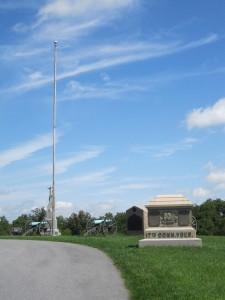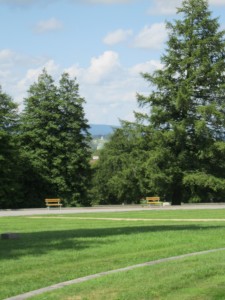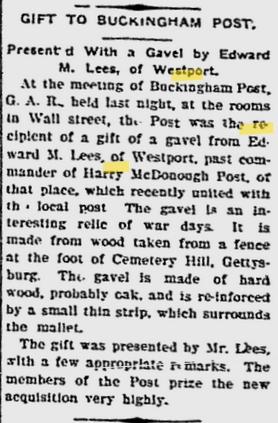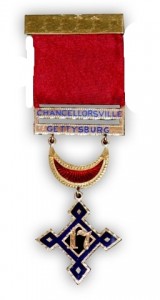
The monuments of the 17th CVI on Barlows Knoll on a bright and sunny August 27th morning.
This morning my son and I headed down to Emmitsburg, Maryland so that we could retrace the route of the 17th CVI the morning of July 1, 1863. I did this once already about 9 years ago…but it was in February after a foot and a half snowstorm. Not surprisingly, it did not appear quite the same.
Nevertheless, there were some other differences besides the weather. In Emmitsburg the area that the 17th CVI camped in on the evening prior to their march to Gettysburg is filled with townhouses and tract homes. The area where Barlow’s division camped has been more developed than other XI Corps locations but still, it is always disheartening to see the march of progress.
Leaving Emmitsburg I’m always amazed by the number of really long and really steep grades. Uphill. We were hot getting out of the car and walking around in shorts and t-shirts. Try as we may it is pretty hard to imagine making that march in heavy wool uniforms, rifle and gear on dusty dirt roads.
Obviously the march to, through and beyond Gettysburg is a contrast between what was then and what is now. The Emmitsburg Road passing through the areas of the second days fight would probably look fairly familiar to the veterans of the 17th. Not so much so as it passes through motel row. Maybe a little familiar moving north on Baltimore Street towards the square…and not much at all.
The Almshouse is gone, of course, and the fields to the right of the Harrisburg Road are all paved over and the home to a Weis market and the Gettysburg campus of the Harrisburg Area Community College. The fields north of the Almshouse site today are planted with corn – lots of corn – right up to Howard Avenue. Not wheat but better than pavement. The Benner farm still looks the same but the area where the Confederate attack on the knoll jumped off from is, of course, housing. The cannon on Jones Avenue are long gone but the markers are still there, at least.
Retracing the retreat from the knoll to Cemetery Hill is difficult since the town has grown out from where it was in 1863. Of course, with the possible exception of the companies that were at the Benner farm, the retreat from the Almshouse was not especially orderly. We did the standard route south on Stratton because it is as good as any, leading us to Cemetery Hill.
The fence line where the 17th was positioned after arriving on Cemetery Hill (a place allegedly pointed out by General Howard) is an area usually forgotten by visitors to East Cemetery Hill. That’s probably because it is a parking lot, tour bus building and hotel. If you look just right you can still see the rear of the Welty house (now the Brickyard Inn), where Confederate sharpshooters traded shots with the 17th. Thanks to some amazing foresight by some influential Gettysburg-ers, East Cemetery Hill is fairly well preserved.
The monument on East Cemetery Hill is almost certainly NOT at the place where Henry Burr captured a CSA soldier – which almost certainly happened many yards further down on what was von Gilsa’s line (another post for another day), so we went there AND to the area around the 41st NYVI where the 17th probably was at the onset of the dusk attack on East Cemetery Hill.
We took pictures – lots of pictures – which will hopefully get posted on the site as a kind of 17th CVI travel album.

Looking to the northeast from the middle of the Connecticut section of the Soldiers National Cemetery includes this view of the Eternal Peace Light Memorial on Oak Hill.
The trip ended up, as it usually does, with a visit to the Connecticut section of the Soldiers National Cemetery. Today I noticed for the first time that, from this section, among the rows containing members of the regiment who never left the field, one can see the Eternal Peace Light Memorial. I like that.




